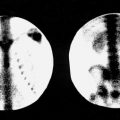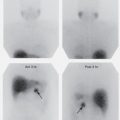Many authors have concluded that the release of patients treated with therapeutic amounts of radiopharmaceuticals is not likely to expose any member of the public, including external and internal dose contributions, to greater than 5 mSv provided that adequate instructions are provided at discharge to the patient and family members. The small percentage of patients needing hospitalization are typically those who have other serious medical conditions or are unable to follow instructions. If the patient is hospitalized the following are important:
- 1.
It is important for the patient to understand the nature of the radionuclide treatment, as well as an overview of the basic restrictions and precautions in place during hospitalization. Patient cooperation is important in minimizing unnecessary incidents and exposures. Before administration of the radionuclide, the procedures and special precautions should be reviewed with the nursing staff. The nursing staff must have specific written instructions for each procedure and should review them before the patient arrives in the room.
- 2.
Immediately after the return of the treated patient to the hospital room from the nuclear medicine department, a radiation safety officer (RSO) should survey the patient and surrounding areas to determine distance and time restrictions for hospital personnel and visitors in the patient’s room. These distances and times are recorded on a form in the patient’s chart and listed on the caution sign on the patient’s door. These signs and labels should remain posted until removal is ordered by the RSO.
- 3.
Hospital personnel and allowed visitors should position themselves as far from the patient as is reasonable except for necessary bedside care. A distance of 2 meters is normally acceptable. In some cases, the RSO may determine that mobile lead shields are needed to reduce exposure to others in adjacent areas. Specific restrictions are noted by the RSO on the room door and in the hospital chart.
- 4.
It is not advisable for pregnant women or children younger than 18 years to enter the hospital room.
- 5.
Dosimeters are required for all hospital personnel who are likely to receive in excess of 25% of the dose-equivalent limit for radiation workers during care of the patient. The RSO identifies hospital personnel within this category and issues the appropriate dosimeters to them.
- 6.
Pregnant personnel should not routinely be assigned to the care of patients under treatment with radioactive materials.
- 7.
Patients receiving radionuclide therapy should be assigned a private room and restricted to the room unless an exception is authorized by the RSO.
- 8.
Limits for release of radionuclide therapy patients from hospitals are given in the US Nuclear Regulatory Commission Regulatory Guide 8-39, published in April 1997. Patient release criteria have been outlined in Chapter 13 . Patients may be released on the basis of administered activity or dose-rate. The specifics for common radionuclides are shown in Table H.1A . There are patients who may be released but who have a level of activity that requires them to be supplied with written instructions on how to maintain doses to other individuals as low as reasonably achievable (ALARA). These activities and dose rates are shown in Table H.1B . Patients may also be released if the calculated maximum likely effective dose to another individual (family and caregivers) is no greater than 0.5 rem (5 mSv). This method requires use of a formula. The recordkeeping requirements are shown in Table H.1C .
TABLE H.1A
Activities and Dose Rates for Authorizing Patient Release a
Radionuclide
Column 1
Activity at or Below Which Patients May Be Released—GBq (mCi)
Column 2
Dose Rate (at 1 m) at or Below Which Patients May Be Released—mSv/hr (mrem/hr) b
198 Au
3.5 (93)
0.21 (21)
51 Cr
4.8 (130)
0.02 (2)
67 Ga
8.7 (240)
0.18 (18)
123 I
6.0 (160)
0.26 (26)
125 I
0.25 (7)
0.01 (1)
131 I
1.2 (33)
0.07 (7)
111 In
2.4 (64)
0.2 (20)
32 P
— c
— c
186 Re
28 (770)
0.15 (15)
188 Re
29 (790)
0.20 (20)
47 Sc
11 (310)
0.17 (17)
153 Sm
26 (700)
0.3 (30)
117m Sn
1.1 (29)
0.04 (4)
89 Sr
— c
— c
99m Tc
28 (760)
0.58 (58)
201 Tl
16 (430)
0.19 (19)
90 Y
— c
— c
169 Yb
0.37 (10)
0.02 (2) 
Stay updated, free articles. Join our Telegram channel

Full access? Get Clinical Tree






